 |
Last time, I went over a list of hand-picked games that were released over the last ten years, compiling the recommended system requirements and averaging the performance required of an average gaming PC (for playing more demanding games) per year and also compared the requirements of those theoretical PCs to the then-current most technically capable console hardware*.
*That was the final graph in the summary. Don't worry, I'm going to go over it again.
This time, as promised, I want to try to make predictions about where the "average" PC will need to be in terms of performance per year for the next five years.
I'm sure the staticians and industry experts are shaking their heads right now - this is, at its best, a fool's errand and, at its worst, naive... but, hey! When has that ever stopped anyone else?! So let's just jump straight in with some graphs!
First off, let's head back to the memory requirements and stretch them out a bit, time-wise:
While quantities of RAM are discrete in nature, there were slight upward slopes for both system RAM and VRAM. Personally, I think the trend in VRAM is easier to predict - as I mentioned last time, AMD is pushing for upwards of 4 GB VRAM on their mid/high-end graphics cards and, given the leaks surrounding the next gen Nvidia cards also increasing their RAM, I think that having 8 GB VRAM as the minimum and 12 GB as the maximum is not very outlandish.
On the other hand, system RAM is more tricky because of the discreteness of its discrete nature... Basically, not being funny, there's only so many combinations of 4, 8 and 16 GB sticks you can put together and still have an optimally-working system. Ideally, that's 2x and 4x those quantities above in a dual-channel motherboard for total quantities of 8, 16, 32 & 64 GB. However, saying that, there were official recommendations for "12 GB" of RAM which doesn't track so well in terms of minimising latency and allowing for the highest-clocked frequencies. But taking that to its logical conclusion gives me the 24 GB figure in the prediction zone above... Which, well, is more likely than 64 GB of system memory!
I guess I should qualify this paritcular chart with the fact that this could probably better be stated to be rasterisation ability. Since ray tracing is still a non-linear function in graphics card performance (at least in terms that is has not yet been proved to be so!) then this is purely a chart that is predicting a normalised equivalent set of similar, non-specialised abilities.
So what gives?
At the end of the day, at the current rate of average performance increase per year, an RTX 2080 Super will not be enough to last for five years at the resolution of 1080p.
That, honestly, is crazy.
What's even more crazy is that this is an average in the midst of a console generation that did not push graphical boundaries in terms of hardware performance. As I aluded to last time, the PS4 Pro and Xbox One X had GPU capabilities roughly equivalent to the RX 470 and RX 580. Those cards were middle-to-low of the road when it comes to performance. The next gen consoles have graphics cards that are high to high-end. Even discounting the extrapolation of the previous 10 years, we can expect graphical requirements to jump by, essentially, an order of magnitude - especially when taking ray tracing capabilities into account!
If recent reports are anything to go by, the current generation of graphics cards are basically trash, not fit for purpose and they'll have an incredibly short consumer lifespan in the grand scheme of things.
Unfortunately, an RTX 2080 Ti, that £1300-ish card will just about last you another 5 years... in rasterisation performance! In ray tracing performance its actual longevity will likely be less than a year from now, if the user employs DLSS. However, if it were up to me, my advice is don't buy any graphics cards right now because they're all relatively terrible value for their money.
If the leaks are anything to go by, the next generation will blow everything currently available out of the water. Don't buy anything... I can't repeat that enough!
I'm sure the staticians and industry experts are shaking their heads right now - this is, at its best, a fool's errand and, at its worst, naive... but, hey! When has that ever stopped anyone else?! So let's just jump straight in with some graphs!
First off, let's head back to the memory requirements and stretch them out a bit, time-wise:
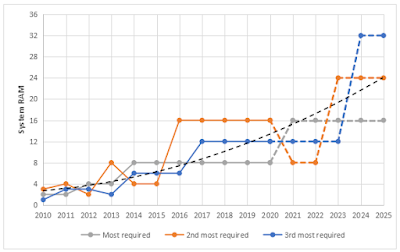 |
| The black dashed line is one I fitted manually to indicate the general trend. The other dashed lines are actual predictions... |
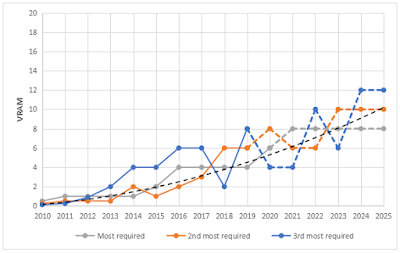 |
| ... again, the black dashed line is a manual fit, the other dashed lines are my predictions... |
On the other hand, system RAM is more tricky because of the discreteness of its discrete nature... Basically, not being funny, there's only so many combinations of 4, 8 and 16 GB sticks you can put together and still have an optimally-working system. Ideally, that's 2x and 4x those quantities above in a dual-channel motherboard for total quantities of 8, 16, 32 & 64 GB. However, saying that, there were official recommendations for "12 GB" of RAM which doesn't track so well in terms of minimising latency and allowing for the highest-clocked frequencies. But taking that to its logical conclusion gives me the 24 GB figure in the prediction zone above... Which, well, is more likely than 64 GB of system memory!
CPU trends are slightly more complex...
I went with a polynomial fit with the Userbenchmark dataset because there was a slight upward curve with all of those trending lines whereas with the Geekbench set, I used linear fits as it seemed to match the data better. The Geekbench multicore score looks like it's curving upwards but I think there are some deviations in the data (i.e. 2015 & 2020).
Just taking a linear extrapolation from the current Geekbench data gives us "credible" figures of just slightly lower than an i7-10700K for single core performance and, when looking at the Userbenchmark data we can see that it hits slightly higher than the i7-10700K in single core performance.
On the other hand, Userbenchmark 4-core and 8-core extrapolations breeze past the performance of stock 3700X and the i5-10600K but the Geekbench multicore performance lies well below the performance of even the R5 3600. In fact, looking at the trends for this theoretical "average" CPU requirement only the i7-10700K comes out on top of all of the multi-core graphs performance.
It's a really interesting result because it's generally accepted that the Zen 2 processors have better multi-core performance than Intel. However, looking at these benchmarks, the 10700K performs amazingly - probably due to the clock frequency advantage it has. At the end of the day, this is a CPU that is pushing the possibilities of the production node and Intel's ring bus architecture to their limits.
Further to this, these are basically the most recommended CPUs from reviewers, tech specialists and, well, tech readerships for current builds within the last six months...
It may surprise you to know, I disagree... somewhat.
First of all, these are all extrapolated expectations based on current trends but it's important to note that current trends are highly based on current console hardware. That was *THE* most significant graph in the previous post. Yes, I can predict graphics hardware based on underpowered PC components as happened in the PS3/360, PS4/XBO and Pro/XBOX generations of hardware but that isn't the case this time around. This time, both Microsoft and SONY have decried that their mid-gen refreshes were collossal wastes of money for little return - people are happy to game on the base system, no matter how unoptimised/underpowered it may be....
Now, that particularly puts the Series S in a weird position... but I did cover that last time. Moving forward from that, both MS and SONY have moved their next gen consoles from lower-to-mid tier hardware into being high-tier beasts. Yes, the XSX beats the hell out of the PS5 in pure graphical abilities but it's also way higher in performance than the currently available PC graphics card lineup. The PS5 has a graphics card that is in line with the middle-to-upper third of the graphics card capabilities but almost surpasses the performance of even the top-end current ray-tracing cards (sorry, that's 2080, not 2080 Ti) without breaking a sweat.
This is not only unprecedented over the period of the last 20 years but it's unprecedented in terms of capital spending on the console hardware of both companies. All indications are that there will be no mid-gen refreshes of the console hardware due to their relative power and expense. We have to be realistic, as consumers, to the potential of either console hardware to provide jumps in "value" over not only their predecessors but also potential future advocates. There was a time when it seemed apparent that console hardware might end up going the way of the mobile phone. That time passed and was lost into the chasm of commercial reality.
Yes, that's correct, I covered this a long time ago. Console hardware does not map well to the phone model: I can get into the nitty-gritty but this basically boils down to the difficulty in form factor vs performance/features and performance/features vs production node. At the end of the day, both MS and SONY are stuck with what their pursestrings can provide, what their suppliers are able to produce... and what their customers are willing to pay. It says a lot that AMD and TSMC have managed to find a way to provide console APUs at a price that is amenable to both platform holders and yet meet and/or exceed current PC mid-high level peformance!
But that doesn't help us here...
 |
| Relative performance of "recommended" PC specs has been pretty linear since the introduction of the PS4 and Xbox One... |
Like I said previously, predicting the average CPU performance per year is complicated... so let's take a look at that graph from the last blogpost... Historic precedent indicates that, actually, CPU performance will tend towards about 2.8x that of the most performant console hardware availble on the market. From this graph, we can see that we're actually around 0.8x that of the predicted console hardware CPU peformance. If this trend holds true, we are not in calm water... but on the beach as the water is rushing out to sea before the tidal wave rushes in to meet us.
Basing both next gen consoles on a Ryzen 7 3700X and this 2.8x performance overhead would require around this much performance if this trend holds true:
 |
| The original and extrapolated performance of a theoretical "average" CPU and the same for a next gen console with a R7 3700X as a basis... |
Now, I may sometimes allow myself some amount of hyperbole but this is not one of those times... This level of performance increase is currently unheard of and simultaneously impossible per what we've heard of for all of the next gen architectures from AMD and Intel. The only "hard" knowledge we have of next gen CPU performance are the statements and forecasts coming from AMD themselves - AMD had a goal of 25x the performance of the 2016 CPUs (I checked and the Athlon X4 845 was the last desktop chip released in that year that I could find) but this would put single core performance up at around 1803 units... making all of those dashed lines in the graph above look miniscule by comparison.
The other piece of evidence is that Forrest Norrod was quoted as saying that AMD expect Zen 3 to provide double digit IPC gains fitting a new architecture. He was also quoted as saying Zen 2 gave more of a performance increase than you would expect because parts of Zen were delayed and put into Zen 2, granting extra improvement over the original Zen. Going from these vague statements, this would put Zen 3 at a lower limit of around 115% to an upper limit of 130% IPC increase over Zen 2, which would put a theoretical Ryzen 7 4700X's performance above that of the i7-10700K by between 8 - 20 %. I think that this is not that crazy of an expectation.
From my point of view, this means that we are more likely to see a recommended spec for PC gaming more closely related to the extrapolated performance in the original graphs above this one.
 |
| If we use a more linear fit the requirements drop significantly for the 8-core performance but not so much for single and 4-core... |
Looking at all those extrapolations in relation to the performance of current CPUs shows us that the R5 3600 is likely to become recommended spec performance some time in the year of 2022. That means that a Ryzen 5 3600 is a bad recommendation as of mid-2020. Anyone who is recommending an R3 3100/3300 or an R5 3600 as a good gaming PC build is not looking at the bigger picture. These pieces of tech are all going to be outdated for AAA gaming by 2022-2023, if not in terms of single-core performance then in terms of multi-core performance. These CPUs will not be up to the task of running the more complex game worlds able to be designed by targetting the next gen consoles... or high refresh rate gaming.
Looking at the extrapolated data, the minimum safe buy for any consumer would be an R7 3700X/3800X or i5-10600K within the same sort of price bracket. If you want to be even safer, buy an i7-10700K at a pretty steep price premium.
However, if you wish to be a smart buyer, then you should wait for the Zen 3 parts. I expect a Zen 3 R7 part would last you longer than anything listed in this comparison and that a Zen 3 R5 might manage you a good deal to 2025 as well. The rumoured Rocket Lake also has some potential surprises in store but we'll have to see how both of these new architectures pan out...
Graphical unspectations...
Okay, that's a crappy subheading. It's a fair cop, gov'ner! At the end of the day, well, I'll just let the graph and extrapolation of data speak for itself:
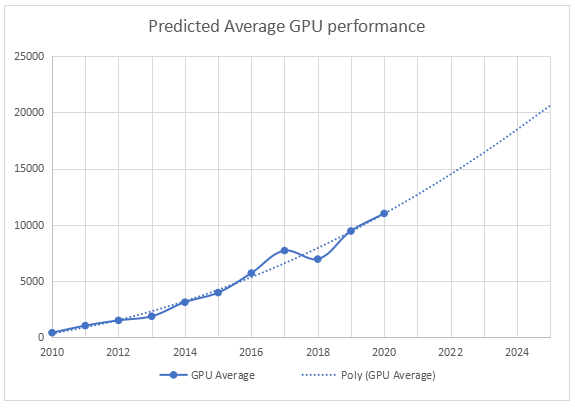 |
| I think I see where this is going... |
I guess I should qualify this paritcular chart with the fact that this could probably better be stated to be rasterisation ability. Since ray tracing is still a non-linear function in graphics card performance (at least in terms that is has not yet been proved to be so!) then this is purely a chart that is predicting a normalised equivalent set of similar, non-specialised abilities.
So what gives?
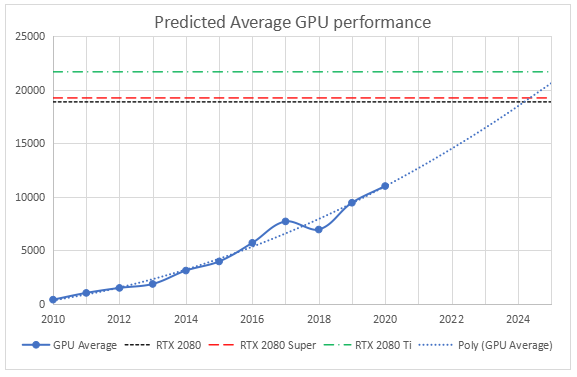 |
| This is not flattering... |
At the end of the day, at the current rate of average performance increase per year, an RTX 2080 Super will not be enough to last for five years at the resolution of 1080p.
That, honestly, is crazy.
What's even more crazy is that this is an average in the midst of a console generation that did not push graphical boundaries in terms of hardware performance. As I aluded to last time, the PS4 Pro and Xbox One X had GPU capabilities roughly equivalent to the RX 470 and RX 580. Those cards were middle-to-low of the road when it comes to performance. The next gen consoles have graphics cards that are high to high-end. Even discounting the extrapolation of the previous 10 years, we can expect graphical requirements to jump by, essentially, an order of magnitude - especially when taking ray tracing capabilities into account!
If recent reports are anything to go by, the current generation of graphics cards are basically trash, not fit for purpose and they'll have an incredibly short consumer lifespan in the grand scheme of things.
Unfortunately, an RTX 2080 Ti, that £1300-ish card will just about last you another 5 years... in rasterisation performance! In ray tracing performance its actual longevity will likely be less than a year from now, if the user employs DLSS. However, if it were up to me, my advice is don't buy any graphics cards right now because they're all relatively terrible value for their money.
If the leaks are anything to go by, the next generation will blow everything currently available out of the water. Don't buy anything... I can't repeat that enough!
In conclusion...
These are pretty serious conclusions. We're heading into a period where users will likely have to upgrade quite often if they do not buy into some of the most expensive, high-end tiers in each piece of hardware in their PC. Want to play games at 1080p native resolution in 2025 on a PC built in 2020? These are the specs you'll need:
- i7-10700K
- 16 GB DDR4 RAM
- RTX 2080 Ti
Next time, I want to take a look at the relative cost of PC gaming. These pieces of hardware are all very expensive and I want to see what the "recommended" PC cost at different points over the last 10 years and, if I'm able, to see how long they each lasted.
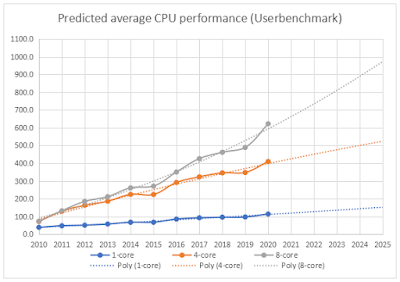


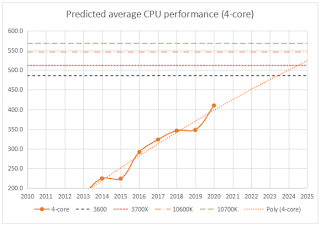


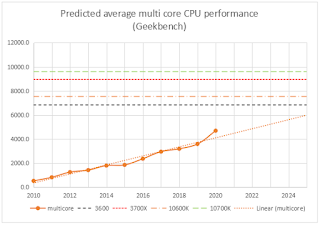


No comments:
Post a Comment